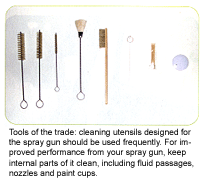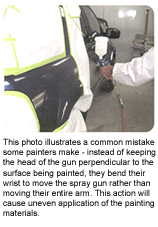> Every painter wants to turn out the best paint job possible. So what’s the key to a successful paint job? A new spray gun, of course.
Actually, a skillful painter with the correct spray gun (notice I said “correct,” not “new”) is the right recipe for an outstanding paint job. But a spray gun is just like any other tool: It has to be matched to the job you’re doing.
How Many Guns to Carry?
Whether the gun is several years old or brand new, you have to take into consideration what material you’re spraying before you choose your gun.
Since the advent of VOC laws, the material you spray has changed too, so it’s even more critical to choose the spray gun based on what you’ll spray with it. For example, there are spray guns designed especially to spray clearcoats. Others are designed for primers and other heavy-bodied materials. Many painters have a spray gun for primers and surfacers, another for basecoats and still another for clearcoats.
If you can afford to have three spray guns, this is the ideal scenario. At the very least, you should consider one spray gun dedicated to spraying only clearcoats. There’s nothing more disconcerting than laying down a beautiful finish and when you start to lay down the final coat of clear, a glob of basecoat comes out and lands right in the middle of the clear. Having a dedicated clearcoat gun will eliminate this from happening. Of course, you can have the same thing happen with a glob of old clear from your last job if you don’t clean your gun properly. (I’ll go into that in detail a little later.)
Choosing Nozzle Setups
So what nozzle setups should be used for which products? Actually, you’ll achieve the best results when you refer to the paint manufacturers technical data sheets for that particular product you’re spraying. They’ve thoroughly tested their products and identified the best needle nozzle combination for each product.
Generally when you have a high-solids clearcoat or single-stage urethane, you should go down in nozzle size to break the material down into smaller particles to get a smoother finish. But some spray gun manufacturers go against this rule and go up in size – so be sure to refer to the gun manufacturers recommendation, as well as to the recommendation from the paint company.
Primer surfacers require a much larger fluid nozzle. Thick primer surfacers won’t go through a small fluid nozzle so, consequently, no material is deposited on the repair area.
Air Errors
Okay. Say you have the right spray gun for the job and it’s equipped with the recommended nozzle setup, but you’re still not getting the optimum performance. Many times, this happens after you buy a new spray gun, especially if it’s a different brand from the one you used in your bodyshop/painting class.
What does this have to do with it, you ask? Plenty!
Maybe you don’t have enough air to properly run your spray gun.
“Come on. Give me a break,” you say. “The compressor is putting out over 150 PSI. How much air do you need?”
The fact of the matter is, PSI (pounds per square inch) doesn’t matter at all. The air consumption of a spray gun is measured by cubic feet per minute (CFM).
Air requirements for a spray gun can range from 2 or 3 CFM for a small touchup gun to as much as 18 CFM for some gravity-feed or siphon guns. The average for most popular guns is around 12.
If you check the output for most 5-hp compressors, it’s around 14 CFM max. Translated, this means that the average 5-hp compressor will efficiently run one spray gun of average air consumption. So if the bodyman at the shop you are working at is running a D/A sander or airfile while you’re painting, there’s a good chance you won’t have enough air to run your spray gun – and your job will suffer the consequences. Even though your spray gun may only use 30 PSI of air, it may exceed the CFM capacity of your compressor.
So your compressor checks out, but the painting performance is still not up to par? Check the air hose and fittings. If you’re using a 1/4-inch air hose, you’re severely hampering air flow and should consider at least a 3/8-inch inner-diameter air hose with high-flow couplers and fittings. This will dramatically improve air flow and efficiency.
Critical Cleaning
The next subject is cleaning. I know, this is the worst part about painting, but thorough cleaning after painting is critical to ensuring your next job will go smoothly.
 Most gun manufacturers include cleaning equipment with their spray guns, which usually consists of a round-barrel brush to clean the passages of the gun and the cup.
Most gun manufacturers include cleaning equipment with their spray guns, which usually consists of a round-barrel brush to clean the passages of the gun and the cup.
You need to remove the fluid needle and nozzle as well as the air cap after each use and thoroughly clean them. Flush the gun with fresh solvent after each use unless the material you sprayed was water-based, in which case, you should first flush and clean the gun with tap water, followed by gun-wash solvent.
Can You Handle a Gun?
The final step in achieving the best job possible is proper handling of the spray gun. Different painters have different techniques and operate at different speeds, but it’s important to hold the spray gun perpendicular to the surface of the car and to keep it at the proper distance.
 Some painters don’t hold the gun perpendicular to the surface until they’ve passed the end of the panel. Toward the end of the panel, they tend to stop the gun and twist their wrist to point the gun to the end of the panel instead of moving their entire arm the length of the panel (much like a brush-stroke-type of method, as if they were painting with a brush). Because of this, the end of the panel does not receive the same even wet coat it would get from extending the gun the entire length of the panel.
Some painters don’t hold the gun perpendicular to the surface until they’ve passed the end of the panel. Toward the end of the panel, they tend to stop the gun and twist their wrist to point the gun to the end of the panel instead of moving their entire arm the length of the panel (much like a brush-stroke-type of method, as if they were painting with a brush). Because of this, the end of the panel does not receive the same even wet coat it would get from extending the gun the entire length of the panel.
Also, gone are the days when you could pour the reducer to your paint, hold the gun 12 to 14 inches or more from the surface and hose it on – since the reducer would allow the paint to flow and level.
But now, with HVLP technology, you need to hold the gun 6 to 8 inches from the surface to maintain control of the fan and of the material you’re spraying. This prevents dry spray and orange peel.
Final Thought
Of course, it’s also worth mentioning, even though it’s not part of this particular article, that a great paint job is almost impossible without proper surface preparation. Stay tuned. We’ll hit on that topic in a future issue of Tomorrow’s Technician.


